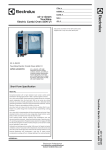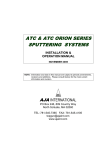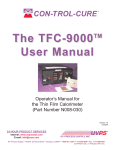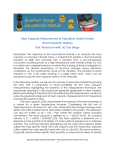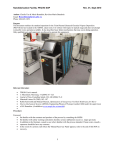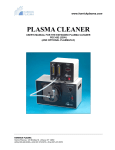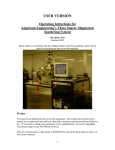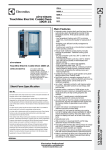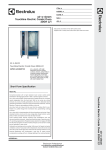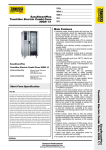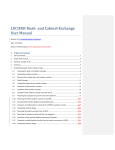Download Overview of the Heat Capacity System
Transcript
C H A P T E R 1 Overview of the Heat Capacity System 1.1 Introduction This chapter contains the following information: 1.2 • Section 1.2 presents an overview of the Heat Capacity option. • Section 1.4 explains the scope of the Heat Capacity option. • Section 1.3 discusses the purpose of measuring heat capacity. • Section 1.5 discusses special features of the Heat Capacity option. What the System Measures The Quantum Design Heat Capacity option measures the heat capacity at constant pressure ⎛ dQ ⎞ Cp = ⎜ ⎟ . ⎝ dT ⎠ p As with other techniques for measuring heat capacity, the Quantum Design Heat Capacity option controls the heat added to and removed from a sample while monitoring the resulting change in temperature. During a measurement, a known amount of heat is applied at constant power for a fixed time, and then this heating period is followed by a cooling period of the same duration. A platform heater and platform thermometer are attached to the bottom side of the sample platform. (See Figure 1-1 on the following page). Small wires provide the electrical connection to the platform heater and platform thermometer and also provide the thermal connection and structural support for the platform. The sample is mounted to the platform by using a thin layer of grease, which provides the required thermal contact to the platform. The PPMS Turbo Pump or Cryopump High-Vacuum option provides a sufficient vacuum so that the thermal conductance between the sample platform and the thermal bath (puck) is totally dominated by the conductance of the wires. This gives a reproducible heat link to the bath with a corresponding time constant large enough to allow both the platform and sample to achieve sufficient thermal equilibrium during the measurement. Quantum Design PPMS Heat Capacity Option User’s Manual 1-1 Section 1.4 Scope of the Heat Capacity Option Chapter 1 Overview of the Heat Capacity System Figure 1-1. Thermal Connections to Sample and Sample Platform in PPMS Heat Capacity Option 1.3 Purpose of Measuring Heat Capacity The measurement of the heat capacity of solids can provide considerable information about the lattice, electronic, and even magnetic properties of materials. Heat capacity measurements, particularly when taken at temperatures that are well below the Debye temperature, directly probe the electronic and magnetic energy levels of a material and hence allow comparisons between theory and experiment. While electronic transport measurements, such as resistivity, are substantially more common, the link between experiment and theory is not always as clear as it is in a heat capacity measurement. Any statistical theory of matter involves computing the density of states and energy levels; these computations naturally lead to predictions of heat capacity numbers. From a practical point of view, materials used in the construction of thermal devices, such as refrigerators, cryostats, and so on, must be characterized thermally. Knowledge of the heat capacity of construction materials is important to any successful thermal design. 1.4 Scope of the Heat Capacity Option 1.4.1 Sample Size and Thermal Characteristics In the Heat Capacity option, the basic puck configuration accommodates small, but not microscopic, samples weighing approximately 1 to 200 mg. Given the thermal characteristics of the calorimeter, this range of masses produces, for most solids, varying relaxation time constants that may be a fraction of a second at 1.9 K or many minutes at 300 K. A single heat capacity measurement can require nearly 10 time constants for the settling time that occurs between measurements. Measuring very large samples can thus be prohibitively time consuming. The addenda heat capacity, however, limits the size of the smallest samples. Measurement accuracy, which is generally a percentage of the total heat capacity, is sacrificed when the sample heat capacity is small compared to the addenda heat capacity. Since the technique used for measuring heat capacity, as described below in Section 1.4.3, is dynamic in nature, the geometry and thermal diffusivity of the sample must be such that the thermal diffusion 1-2 PPMS Heat Capacity Option User’s Manual Quantum Design Chapter 1 Overview of the Heat Capacity System Section 1.4 Scope of the Heat Capacity Option time in the sample is small compared to the time constant of the measurement. In cases where the amount of time it takes for the sample to reach internal thermal equilibrium is not small compared to the measurement time, the resulting heat capacity measurement will be too small. Although this problem is indicated in the software as a poor thermal contact between the sample and the sample holder, it is important to use samples that have relatively fast thermalization times to get the correct heat capacity numbers. In cases where the thermal diffusion time in the sample is large, it is necessary to use samples that have a relatively flat geometry, so as to reduce the thermal path through the sample. 1.4.2 Temperature Range The Heat Capacity option has no fundamental temperature range limit other than the PPMS temperature range. However, relaxation techniques are traditionally used at temperatures that are below approximately 100 K, because relaxation times are relatively short below 100 K. The Heat Capacity option can measure heat capacity up to about 400 K. The percent resolution of the thermometry is relatively constant over the temperature range. Hence, at higher temperatures, the absolute temperature resolution is somewhat poorer. 1.4.3 Measurement Technique Many different measurement techniques (Stewart 1983) are optimized for different sample sizes and accuracy requirements (high resolution versus accuracy). The Quantum Design Heat Capacity option uses a relaxation technique that combines the best measurement accuracy with robust analysis techniques. After each measurement cycle⎯which is a heating period followed by a cooling period⎯ the Heat Capacity option fits the entire temperature response of the sample platform to a model that accounts for both the thermal relaxation of the sample platform to the bath temperature and the relaxation between the sample platform and the sample itself (Hwang, Lin, and Tien 1997). The effect of the relaxation between the platform and sample must be considered when the thermal connection shared by the sample and platform is poor. By modeling this effect, the software can report the correct heat capacity values despite such poor contact. 1.4.4 Pressure in Sample Chamber The wires connecting the sample platform to the puck frame create well-controlled thermal links to the thermal bath. To eliminate alternate thermal links through residual gas, the pressure within the probe must be less than approximately 1 mTorr. The PPMS High-Vacuum option, which operates in conjunction with the Heat Capacity option, maintains this low pressure. A charcoal holder is used as a cryopump to help decrease the pressure at the bottom of the probe at temperatures below 10 K. When the High-Vacuum option is activated, base pressures of approximately 0.01 mTorr are typical at the top of the probe. Quantum Design PPMS Heat Capacity Option User’s Manual 1-3 Section 1.5 Special Features of the Heat Capacity Option Chapter 1 Overview of the Heat Capacity System 1.5 Special Features of the Heat Capacity Option 1.5.1 Acquisition Hardware Relaxation techniques require accurate time-resolution of the temperature response of the sample platform during the measurement cycle as well as precise correlation of the heater output and the temperature response. Fast, accurate thermometry is essential for the best signal-to-noise ratio. These requirements for relaxation calorimetry place considerable demands on the data acquisition portion of a system. Rather than attempt to adapt existing data acquisition hardware to the task, Quantum Design has developed a high-performance controller optimized for relaxation calorimetry. 1.5.2 Calorimeter Puck and Sample Mounting As with standard PPMS units, the calorimeter is a puck that you insert into the sample chamber. The Heat Capacity option includes more than one puck, so you can prepare a second sample on the second puck while the first puck is in the sample chamber. When you have measured the first sample, you may immediately insert the second puck and measure the second sample without having to remove the sample from the first puck. You use a sample-mounting station to hold the puck when you mount and remove samples. The station uses a puck interlock arm and vacuum suction to stabilize the puck and the sample platform. By stabilizing the sample platform, the station helps protect the delicate, thermally conducting wires that connect the platform to the puck frame. 1.5.3 Puck Calibration The Heat Capacity software includes a fully automatic thermometer calibration routine that uses the PPMS system thermometer as the reference thermometer to produce temperature calibrations for the puck thermometer, platform thermometer, and platform heater. The calibration routine thus reduces the cost of the pucks, because the pucks do not require factory calibration. Moreover, the calibration routine allows you to design custom pucks that have different characteristics but that can still work with the Heat Capacity option if you use the standard calibration procedure to calibrate the pucks. 1.5.4 Automation Environment You may program the Heat Capacity option, just as you may program other PPMS measurement options, to automatically acquire data. You use sequences, which are the PPMS automation language, to run any number of measurement macros. You may also run each macro independently. Sophisticated data analysis, which is part of the Heat Capacity option, is critical to your ability to run heat capacity measurements while you are away from the system. Monitoring each measurement and its associated fit in order to detect potential problems is unnecessary. The Heat Capacity software writes all relevant diagnostic information and the heat capacity numbers to an open data file. When the measurement is complete, you examine this data file. Errors are automatically computed for each sample heat capacity measurement. 1-4 PPMS Heat Capacity Option User’s Manual Quantum Design




